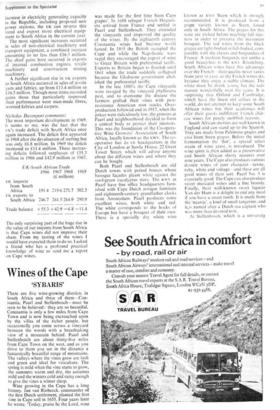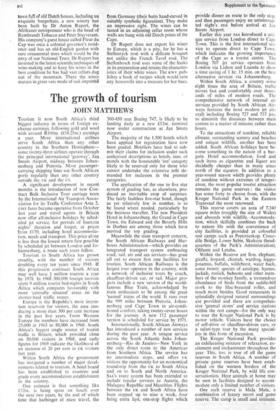Wines of the Cape
`SYBARIS'
There are five wine-growing districts in South Africa and three of them—Con- stantia, Paarl and Stellenbosch—must be seen to be believed : they are so beautiful. Constantia is only a few miles from Cape Town and is now being encroached upon by the villas of the richer people, but occasionally you come across a vineyard between the woods with a breathtaking view of a mountain behind. Paarl and Stellenbogch are about thirty-five miles from Cape Town on the west, and as you drive to them you see in the distance a fantastically beautiful range of mountains. The valleys where the vines grow are lush and green and ideal for viticulture. The spring is mild when the vine starts to grow, the summers warm and dry, the autumns mild and the winters cold and rainy enough to give the vines a winter sleep.
Wine growing in the Cape has a long history. Jan van Riebeeck, commander of the first Dutch settlement, planted the first vine in Cape soil in 1655. Four years later he wrote. 'Today, praise be the Lord, wine was made for the first time from Cape grapes'. In 1688 refugee French Huguen- ots arrived from France and settled in Paarl and Stellenbosch. They extended the vineyards and improved the quality of the wines. By the eighteenth century Constantia wines had become world famed. In 1805 the British occupied the Cape and while the Napoleonic wars raged they encouraged the export of wine to Great Britain with preferential tariffs. Exports to Britain began to flourish until 1861 when the trade suddenly collapsed because the Gladstone government abol- ished the preferential tariffs.
In the late 1880's the Cape vineyards were ravaged by the vineyard phylloxera pest, and to overcome the disease the farmers grafted their vines with pest- resistance American root stocks. Over- production followed and in 1917, when the prices were ridiculously low, the growers at Paarl and neighbourhood decided to form a central body to protect their interests. This was the foundation of the Co-opera- tive Wine Growers' Association of South. Africa, locally known as the Kwv. The co- operative has its tx headquarters in the City of London at Sawfa House, 22 Great Tower Street, which will advise anyone about the different wines and where they can be bought.
Both Paarl and Stellenbosch are old Dutch towns with period houses whose baroque facades gleam white against the cool-green eucalyptus trees. The Kwv at Paarl have fine office headquarters furn- ished with Cape Dutch antique furniture and eighteenth-century grandfather clocks from Amsterdam. Paarl produceg some excellent wines, both white and red. The white corresponds to the hocks of Europe but have a bouquet of their own. There is a specially dry white wine known as KWV Steen which is strongly recommended. It is produced from a grape variety known as Steen. found only in South Africa. The grapes for this wine are picked before reaching full ripe- ness in order to preserve the maximum bouquet. The red wines from the black grapes are light-bodied or full-bodied. com- parable with the clarets and burgundies of France. A medium burgundy not unlike a good beaujolais is the kw Roodeberg. South African ‘‘ Ines have this advantaee over the French--- their quality never varies from year to year. as the French wines do. because they enjoy a stable climate. The white must be drank young but the reds mature wonderfully over the years. It is surprising that Oxford and Cambridge, which have the finest old cellars in the world, do not attempt to keep some South African wines but their academics will offer their guests indifferent French chât- eau wines for purely snobbish reasons.
South African sherries are well known in England and can stand up to the Spanish. They are made from Palomino grapes and also from Steen grapes. Before the initial fermentation the 'for', a special select strain of wine yeast, is introduced. The wine spirit is-then added as a preservative and South African sherry matures over nine years. The Cape also produces various dessert wines of port character—tawny, ruby, white and vintage—and these are all good wines of their sort. Paarl No. 5 is especially good. The Cape can also produce sweet muscatel wines and a line brandy. Finally, their well-known sweet liqueur Van der Hum is a delight to end any meal if you have a sweet tooth. It is made from the 'naartje', akind of small tangerine, and it.is named after a Dutch sea captain who was more than devoted to it.
At Stellenbosch, which is a university town full of old Dutch houses, including an exquisite burgerhuis, a new winery has been built by Dr Anton Rupert, the Afrikaner entrepreneur who is the head of Rembrandt Tobacco and Peter Stuyvesant. His company's guest house called Fleur du Cap was once a colonial governor's resid- ence and has an old-English garden with rare ornamental trees which would be the envy of our National Trust. Dr Rupert has invested in the latest scientific techniques of wine-making and to keep his wines in the best condition he has had vast cellars dug out of the mountain. There the wines mature in great vats made of oak imported from Germany (their butts band-carved in suitably symbolic figuration). They make an impressive sight. The wines can be tasted in an adjoining cellar room whose walls are hung with old Dutch prints of the Cape. Dr Rupert does not export his wines to Europe, which is a pity, for he has a Stellenryck rose with a delicate bouquet not unlike the French Tavel rosé. The Stellenbosch rosé uses some of the husks in its preparation and retains the character- istics of their white wines. The icwv pub- lishes a book of recipes which would turn any housewife into a treasure for her bass.























































 Previous page
Previous page